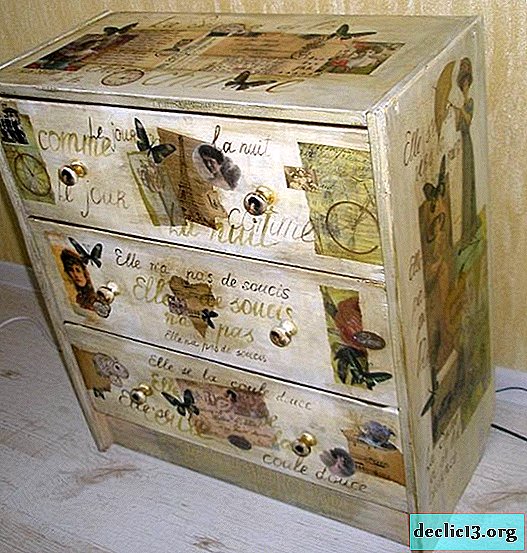Decoupage methods on furniture, popular techniques
There are many ways to transform bored items, adding a twist, freshness to the interior. These are different ways of coloring, pasting with decorative film, screen drawings. Most do not require expensive equipment, fixtures, materials, or even artist skills. One of such methods is decoupage of furniture, which allows to give originality to furniture.
Decoupage Features
Do-it-yourself furniture decoupage is decorating objects with pictures cut out of paper. Three-layer napkins and decoupage cards are used. You can decorate in this way not only furniture, but caskets, notebooks, photo albums, plates. Even candles and handmade soap are decorated.
It is valuable in decoupage that any ideas can be realized by a person who does not know how to draw. After all, decoupage is done simply. The easiest option is to stick a napkin on a previously prepared surface and fix it with varnish. Moreover, there are a lot of lessons on this topic, including for beginners.
And if you use different staining methods, add bulk parts or artificially age using the cracking effect, you can achieve different effects. For example, to create the impression that the little thing is old. An interesting decoupage of furniture in the styles of shabby chic or provence, which is now in fashion.
Decoupage is a huge scope for imagination. Engaged in this type of applied art, everyone can feel like a creative person and create a unique interior in their home.






Kinds
To list all the varieties of decoupage, perhaps there are not enough fingers on both hands. Such styles of design are popular:
- shabby chic - with floral ornaments and a worn effect in light colors;
- Provence - creates the effect of French antiquity;
- in vintage style - here the main technique is artificial aging;
- in ethnic styles - ornaments are created that are characteristic for a particular country;
- simple city - here products are decorated with improvised means: newspapers, children's drawings and so on;
- in country style - this creates a rustic comfort in the house;
- in Victorian style - in the spirit of the English ageless classics.
This is about styles. The technician is also a lot. There are many master classes on furniture decoupage, including with video. So, if you wish, you can master all the styles and techniques of decoupage. Next, we will get acquainted with each decoupage technique in a little more detail.





Classical
This is the founder of the whole trend, as well as the simplest decoupage technique on furniture and other items. The picture or ornament is cut out of a napkin, rice paper or printed image. Decoupage cards are also used. The surface for decoupage furniture is pre-prepared. It is cleaned, degreased, primed or painted.
The image is superimposed on the dried surface and smeared with a PVA moistened with glue or an acrylic brush. In this case, you need to properly align the paper. With classic decoupage, the picture is not superimposed on the glue, but is impregnated with it from above. That is why types of paper that absorb glue well are used for decoration.
Ideally lays down a drawing on furniture from a chipboard or the massif. Decoupage of doll furniture made of plywood or plastic is also carried out.
After gluing, the image must be dried, and then apply the varnish in two layers. Between layers it is better to resort to a polishing procedure to make the finished product smooth. The classic technique is suitable for beginners due to its simplicity.



Back
Suitable for decorating transparent objects. Unlike the classical method, the ornament is attached to the back of the item. A good way to make a decoupage of kitchen furniture with your own hands if there are glass inserts in the cabinet doors. Thus, you can decorate the glass table.
Here everything happens in the reverse order. Here's how it looks in stages:
- the picture is glued;
- a background is applied to it - because the image will shine through from the back of the subject;
- over the background carry out varnishing.
If any additional decor is used, then it is glued at the beginning of the process, in front of the picture or simultaneously with it. Details of the picture can be drawn with a thin brush for clarity of the picture.
Do-it-yourself reverse decoupage is no more complicated than classic. In addition, with its help it is possible not only to refresh glass furniture, but also to mask its small defects.


Art
Here you create complete images that mimic a painting. In this way, you can make both decoupage on furniture and other interior items, as well as independent paintings for decorating the house.
Art decoupage is the most difficult of all. Before embarking on it, it is better to get your hand on the classic and other, simpler techniques.
The picture is pasted here in the same way as in previous techniques. Decoupage cards, napkins are used. The difference is that the details of the image are drawn and rendered so that it merges with the background, it becomes a single whole.
Often used when the cut element is too small for the surface to be decorated. Therefore, it is necessary to finish the missing details, and so that they look with an element cut out of paper as a whole. To achieve this effect, you need to have artistic skills and good knowledge of paints and brushes.



Decopatch
In this case, small pieces of special paper are used for decoration. Such paper is thin, usually has colorful ornaments and patterns. The method is good to update old furniture, because scraps of variegated paper can cover all defects.
The decopatch is compared to a quilt, only of paper. This technique is suitable not only to make decoupage of old furniture with your own hands, but also to make cute figures in ethnic style. For example, animal figurines. An interesting option is when newspapers and magazines are torn to pieces.
A kind of decopatch is lamination, or laminate. In this case, pieces of paper or fabric, dry leaves and other decorative elements are impregnated with acrylic varnish and glued to the subject. After drying, you can get a smooth, shiny laminated surface. The strength and water resistance of the coating allows this technique to be carried out on polished furniture.


Casting shadows
This technique is used to create a three-dimensional effect of the picture. In this style, decoupage is very interesting from an artistic point of view. Shadows are induced by acrylics. To do this, a light shading is done around the glued motif with a dry sponge or semi-dry brush. Such a haze is created by a paint of a darker shade than the color of the picture. Paint on a sponge should be typed quite a bit.
The picture should dry well before casting the shadows. In order to reduce the risk of errors, it is better to cover the motif with a matte protective varnish. In this case, if the varnished surface is stained with paint, it will be easy to wash off.
Shadow paint does not have to be gray or black. The options are interesting when it is the same shade as the color of the picture, only darker. For example, a dark blue shadow for a light blue vase. With this technique, you can beat even the simplest ideas interestingly.


Craquelure
Decoupage of eggshell furniture can turn ordinary objects into vintage ones. Shells create a cracking effect. This technique is called craquelure. The chicken eggshell is glued in small pieces onto a painted surface. It is better to choose a dark background so that the space between these pieces is more noticeable.
Here are the step-by-step instructions:
- paint the surface with acrylic paint and dry it;
- with glue to attach pieces of shell. Gaps can be made barely noticeable, but can be wide, at the discretion;
- stick napkins or decoupage cards on top;
- if necessary, draw, cast shadows and so on;
- dry the motive to varnish.
Egg craquelure is the best way to restore old furniture. The shell covers the surface with a dense layer, reliably hiding all defects. There are also special craquelure varnishes, which when dried form a network of cracks in the picture.




Volumetric decoupage
Volumetric decoupage is the most interesting way of decorating. There are tons of ideas. This is a decoupage of furniture with lace, when lace motifs are glued. Using decoupage of furniture with a cloth allows you to give the surfaces an unusual rough texture. In addition, other volumetric elements can be used.
If napkins or decoupage cards are used, then to add volume the motif is cut out in several copies. These pieces are glued to each other, so that the resulting image protrudes above the decorated surface.
Decoupage fabric can transform both large pieces of furniture and small interior details. The fabric is laid with folds, which are fixed with glue "tightly". Just like a craquelure, this is an excellent restoration of old furniture at no particular cost and a way to transform the interior of the house. In this way, even decoupage of a polished ragged surface is possible.



Common mistakes
When taking on the transformation of the elements of your home, the main thing is not to make mistakes, especially for beginners. Decorating is not easier than repairing, and sometimes even more difficult. Even though decoupage is one of the easiest ways. The most common errors are:
- poor-quality surface preparation - if the furniture is made of wood or chipboard, it is important to carefully sand it. If roughness remains, the picture will not lie flat. It is important to degrease plastic or glass items, otherwise the paper will peel off;
- lack of primer - there must be a primer layer between the surface and the picture. If you neglect it, then over time, fungus or mold may appear, especially if the place of the subject is a kitchen or bathroom, where it is wet and warm;
- sticking motives without thinking. Before gluing pictures, they should be laid out on the surface and choose the optimal location. If you immediately proceed to sticking, you can get quite what it seemed;
- uneven gluing of motives - during decoupage it is important to carefully level the paper with a brush, expelling air. If wrinkles form, you need to remove them immediately;
- poor-quality varnishing - it is better to collect less varnish on the brush than more. Otherwise, inflows and streaks may form, which then can not be removed.
Generally speaking, it is important to do decoupage slowly, slowly and thoughtfully. As, however, and any other decoration work. This type of creativity is a great way to transform boring furniture, restore it by simple methods and bring a fresh stream into the interior, especially when you know how to decoupage furniture.





Video
Photo































